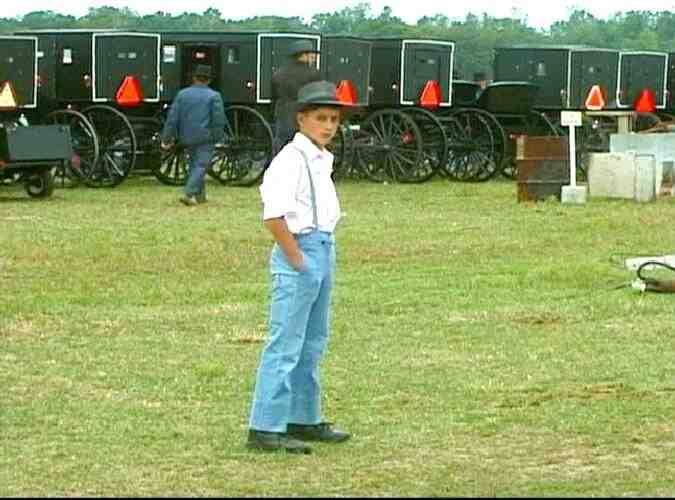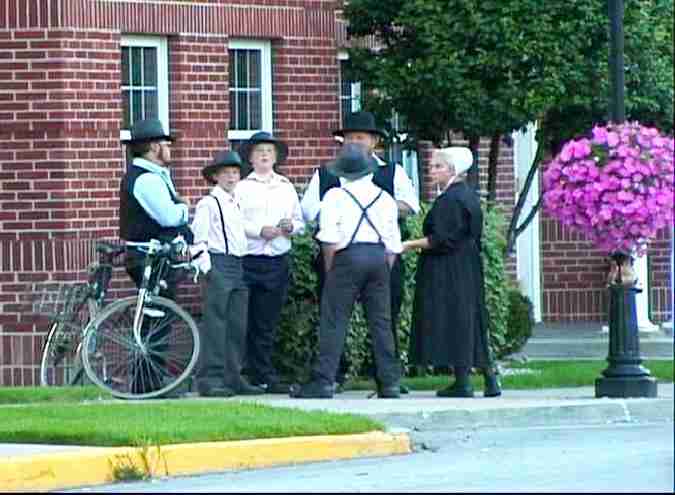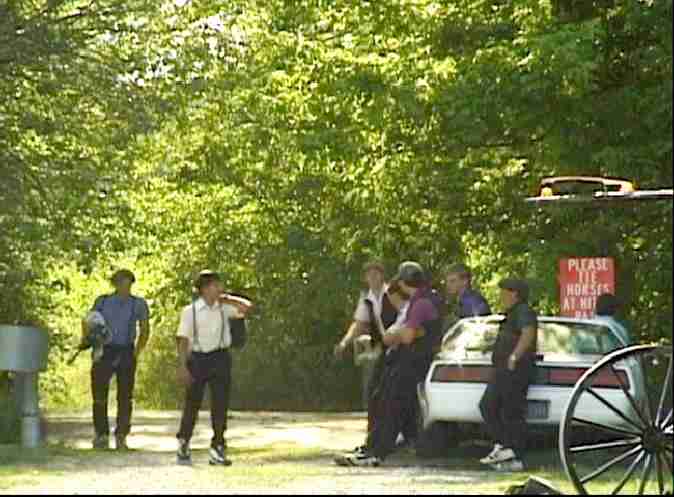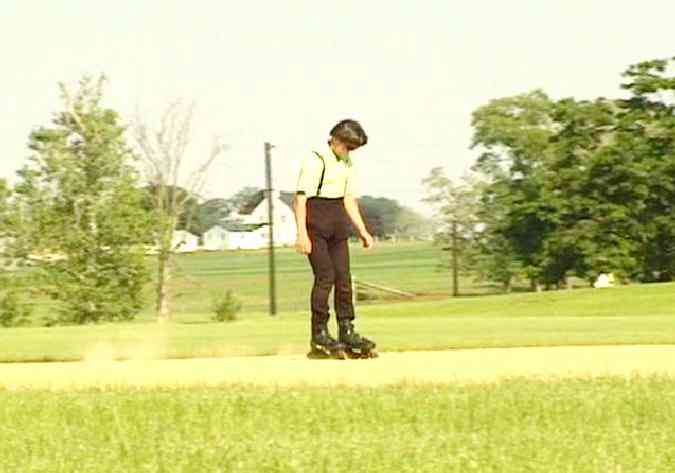
The Devil's Playground (US, 2001)

Figure 1.--The photographs here show Amish boys in their traditional dress, not in the "english" dress which many of them adopt during "Rumspringa." This photograph shows an Indiana boy of about 10 years wearing blue trousers with black suspenders and a white shirt. Notice his hat, which most Amish boys wear when they are outdoors. The pants are similar to blue jeans but styled somewhat differently. Such trousers are often handmade at home. Note the broad-brimmed hat and the buggies in the background with their florescent triangle (necessary to prevent accidents on modern American roads where the horse-drawn buggies have to compete with the modern automobile).
|
|
The documentary "The Devil's Playground" (2001) was directed by Lucy Walker. It dealt with the life of Amish youth in modern America. It was filmed princpally in LaGrange County, Indiana, and in Lancaster County, Pennsylvania, which are both centers of Amish culture. The Amish were a splinter religious group, originally founded in 1693 in central Europe because they disapproved of infant baptism and
insisted that a person couldn't legitimately become a true member of their
church until he or she was at least sixteen. At this point they were
baptized, joined the Amish church, and swore to live the rest of their lives
simply, shunning the ways of the modern world as much as possible. They were
severely persecuted in Europe for their views on baptism, and by 1860 had
abandoned Europe entirely for life in America. Most of the Amish are hard-
working, thrifty, productive farmers, but they have other skills as well such
as carpentry, sewing, horse-shoeing, etc. The Amish educate their children in
separate schools through the 8th grade and from that point onward discourage
further education as leading to "the pride of life". For this reason also
they refuse to use electricity, automobiles, cameras, and many other modern
conveniences. But they are not so much against modern technology for its own
sake (they do make certain compromises with the modern world) as they are
determined to avoid aspects of modern culture that would tend to break up
their close-knit community with its values of self-reliance and helping each
other. The most visible aspect of their essentially rural culture is the
horse-drawn buggy--their major means of transportation.
Filmology
The documentary "The Devil's Playground" (2001) was directed by Lucy Walker.

Figure 2.-- This photograph shows a group of Amish boys in their typical black
trousers and hats with white shirts. This is the Amish "dress uniform" for
boys, usually worn to church. Note the bicycle, which is permitted in Amish
life. The brick building (probably in Lancaster, Pa.) may be an Amish church.
|
|
The Subject
The film deals with the life of Amish youth in modern America.
Location
It was filmed princpally in LaGrange County, Indiana, and in Lancaster County, Pennsylvania, which are both centers of Amish culture.
The Amish were a splinter religious group, originally founded in 1693 in central Europe because they disapproved of infant baptism and
insisted that a person couldn't legitimately become a true member of their
church until he or she was at least sixteen. At this point they were
baptized, joined the Amish church, and swore to live the rest of their lives
simply, shunning the ways of the modern world as much as possible. They were
severely persecuted in Europe for their views on baptism, and by 1860 had
abandoned Europe entirely for life in America. Most of the Amish are hard-
working, thrifty, productive farmers, but they have other skills as well such
as carpentry, sewing, horse-shoeing, etc. The Amish educate their children in
separate schools through the 8th grade and from that point onward discourage
further education as leading to "the pride of life". For this reason also
they refuse to use electricity, automobiles, cameras, and many other modern
conveniences. But they are not so much against modern technology for its own
sake (they do make certain compromises with the modern world) as they are
determined to avoid aspects of modern culture that would tend to break up
their close-knit community with its values of self-reliance and helping each
other. The most visible aspect of their essentially rural culture is the
horse-drawn buggy--their major means of transportation.
This film is highly unusual because normally the Amish reject the idea of
being photographed as promoting vanity and pride of self. (The Amish people
who appear in the film are either teenagers who are undergoing a kind of
identity crisis or older Amish people who believed that the documentary served
a noble enough purpose to allow for an exception to their disapproval of the
camera.)

Figure 3.--he third photograph is interesting because it illustrates the clash of two cultures. The boys are gathering or "hanging out" near a modern parked car which obviously interests and attracts them and which one of them may be
allowed to drive during his Rumspringa. But there is also a sign near the car
about the place to hitch horses, which is the transport the Amish traditionally rely on.
|
|
Clothing
For reasons of avoiding temptations to pridefulness the Amish wear very
simple unadorned clothing. The boys wear mainly farm clothes--always long
pants (usually with suspenders since belts are frowned upon as too fancy and
impractical), plain colored or white shirts, and broad-brimmed hats (either of
straw or felt). Some of the Amish trousers are styled like navy trousers with
a button flap in front instead of a fly. Zippers are not generally used in
Amish clothing. The children don't wear shorts even for play, and the girls
always wear skirts.
The first photograph here shows an Indiana boy of about 10 years wearing blue trousers with black suspenders and a white shirt (figure 1). Notice his hat, which most Amish boys wear when they are outdoors. The pants are similar to blue jeans but styled somewhat differently. Such trousers are often handmade at home. Note the broad-brimmed hat and the buggies in the background with their florescent triangle (necessary to prevent accidents on modern American roads where the horse-drawn buggies have to compete with the modern automobile).
The second photograph shows a group of Amish boys in their typical black
trousers and hats with white shirts (figure 2). This is the Amish "dress uniform" for
boys, usually worn to church. Note the bicycle, which is permitted in Amish
life. The brick building (probably in Lancaster, Pa.) may be an Amish church.
The third photograph is interesting because it illustrates the clash of two
cultures (figure 3). The boys are gathering or "hanging out" near a modern parked car
which obviously interests and attracts them and which one of them may be
allowed to drive during his Rumspringa. But there is also a sign near the car
about the place to hitch horses, which is the transport the Amish
traditionally rely on. Note that some of the boys wear the traditional dark
trousers and suspenders, while other boys seem to be in "english" dress--part
of their exploration of the larger American culture.
The fourth shot shows an Amish boy trying out his new "in line" skates,
apparently allowed by his parents because skating does not disrupt the basic
values of Amish family life (figure 4). He wears a mint green shirt with his black
trousers and suspenders. This photo also is an interesting symbol of the
mixed culture (modern and old-fashioned) to which contemporary Amish boys are
exposed.

Figure 4.-- This photograph shows an Amish boy trying out his new "in line" skates,
apparently allowed by his parents because skating does not disrupt the basic
values of Amish family life. He wears a mint green shirt with his black
trousers and suspenders. This photo also is an interesting symbol of the
mixed culture (modern and old-fashioned) to which contemporary Amish boys are
exposed.
|
|
Rumspringa
The film treats that period in an Amish teenager's life
known as "Rumspringa"--a time at about age 16 when the parents let the boy or
girl go freely into the outside world to discover for himself or herself what
the non-Amish culture is like. They experiment with "English" clothes (their
term for modern American dress), with drinking, smoking, and sometimes even
with illegal drugs. The parents feel that their children will not make good
Amish people until they know the world they are renouncing. Some of course
never come back home, while others do become baptized and join the Amish
church only to leave it at a later point. It is a difficult transition for
most teenagers. These children experience television and fast cars for the
first time and often find it too difficult to give these luxuries up once they
have experienced them.
HBC

Navigate the Boys' Historical Clothing Web Site:
[Return to the Main alphabetical "Da-De"]
[Return to the Main alphabetical movie page]
[Introduction]
[Activities]
[Biographies]
[Chronology]
[Clothing styles]
[Countries]
[Bibliographies]
[Contributions]
[Essays]
[FAQs]
[Glossaries]
[Satellites]
[Tools]
[Boys' Clothing Home]
Created: May 13, 2004
Last updated: May 13, 2004






